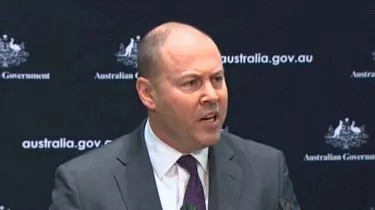Invest
Government flags US-style bankruptcy rules
Small businesses with less than $1 million in liabilities will be given the opportunity to restructure their affairs and continue to trade under proposed changes by the federal government.
Government flags US-style bankruptcy rules
Small businesses with less than $1 million in liabilities will be given the opportunity to restructure their affairs and continue to trade under proposed changes by the federal government.

Australia is looking to adopt key aspects of the US Chapter 11 Bankruptcy Code as a way of keeping businesses afloat during the COVID-19 pandemic.
Under the change, businesses with liabilities of less than $1 million will be allowed to continue trading while they develop a debt restructuring plan within 20 business days.
The Treasury states these reforms will cover around 76 per cent of business subject to insolvency today and 98 per cent of businesses that have fewer than 20 employees.
“As the economy continues to recover, it will be critical that distressed businesses have the necessary flexibility to either restructure or to wind down their operations in an orderly manner,” said Treasurer Josh Frydenberg.

“Together, these measures will reposition our insolvency system to reduce costs for small businesses, reduce the time they spend during the insolvency process, ensure greater economic dynamism, and ultimately help more small businesses get to the other side of the crisis.”
CreditorWatch chief economist Harley Dale warned that a considerable number of insolvencies would emerge, with many businesses unlikely to recover from the “forced economic hibernation” imposed in March. That remains the case, regardless of any legislation that allows companies to continue trading while insolvent.
“It is crucial that the federal government continues to provide support to businesses and households in a year of unprecedented economic challenge,” Mr Dale said.
“However, while the decision to apply US-style Chapter 11 bankruptcy laws that will allow small businesses to trade their way out of insolvency is well intentioned, it will do little to generate jobs and growth down the track.”
Instead, Mr Dale believes businesses that cannot survive without government support should not be the focus.
The focus should therefore be on those small businesses that have a viable capability of emerging from the COVID environment with their balance sheets intact and an ability to successfully trade without government support.
“There’s a lot of uncertainty out there for creditors as they don’t quite understand how this will affect them,” Mr Dale said. “Ultimately, if it helps businesses survive or at least flattens the inevitable insolvency curve, it’s a good thing. The government should be commended for working on such big policy changes in short, pressure-filled time.”
About the author

About the author


Economy
Australia’s softening labour market puts another RBA cut in play — here’s what business should do now
A four-year high in unemployment has revived expectations the Reserve Bank could deliver another rate cut as soon as November. With quarterly GDP growth running at 0.6 per cent and annual growth at ...Read more

Economy
Rising CPI reinforces RBA’s stance as rate cut expectations remain: State Street
State Street Global Advisors says the Reserve Bank of Australia (RBA) is likely to hold its current policy outlook following the release of September quarter inflation data, which showed an unexpected ...Read more

Economy
NSW SES boosts tsunami preparedness ahead of World Tsunami Awareness Day
As World Tsunami Awareness Day approaches on 5 November, the New South Wales State Emergency Service (NSW SES) is ramping up efforts to enhance tsunami preparedness along the east coastRead more

Economy
Lifesaving Regional Response Strengthened with New NSW SES Vehicles
In a significant boost to regional emergency services, the NSW State Emergency Service (SES) has unveiled 11 new Community First Response (CFR) vehicles, designed to enhance the speed and safety of ...Read more

Economy
Australia's June quarter GDP growth driven by consumer and government spending
Australia's economy has shown unexpected resilience in the June 2025 quarter, with household and government consumption driving growth despite a significant decline in public investmentRead more

Economy
Australia's GDP surprise is real but operators should heed the growth mix warning light
Australia’s June-quarter growth beat expectations on the strength of household consumption and government spending, even as public investment sagged. The upside surprise signals resilience, but the ...Read more

Economy
Households carried the quarter: what Australia’s upside GDP surprise means for strategy now
Australia’s economy expanded faster than expected in the June 2025 quarter, with GDP up 0.6 per cent quarter-on-quarter and 1.8 per cent year-on-year — the strongest pace in two years. The kicker ...Read more

Economy
Inflation dynamics in Australia: Electricity subsidies and labour market in focus
In a recent economic analysis, experts from State Street have highlighted significant developments in Australia's inflation landscape, attributing the changes primarily to the withdrawal of ...Read more

Economy
Australia’s softening labour market puts another RBA cut in play — here’s what business should do now
A four-year high in unemployment has revived expectations the Reserve Bank could deliver another rate cut as soon as November. With quarterly GDP growth running at 0.6 per cent and annual growth at ...Read more

Economy
Rising CPI reinforces RBA’s stance as rate cut expectations remain: State Street
State Street Global Advisors says the Reserve Bank of Australia (RBA) is likely to hold its current policy outlook following the release of September quarter inflation data, which showed an unexpected ...Read more

Economy
NSW SES boosts tsunami preparedness ahead of World Tsunami Awareness Day
As World Tsunami Awareness Day approaches on 5 November, the New South Wales State Emergency Service (NSW SES) is ramping up efforts to enhance tsunami preparedness along the east coastRead more

Economy
Lifesaving Regional Response Strengthened with New NSW SES Vehicles
In a significant boost to regional emergency services, the NSW State Emergency Service (SES) has unveiled 11 new Community First Response (CFR) vehicles, designed to enhance the speed and safety of ...Read more

Economy
Australia's June quarter GDP growth driven by consumer and government spending
Australia's economy has shown unexpected resilience in the June 2025 quarter, with household and government consumption driving growth despite a significant decline in public investmentRead more

Economy
Australia's GDP surprise is real but operators should heed the growth mix warning light
Australia’s June-quarter growth beat expectations on the strength of household consumption and government spending, even as public investment sagged. The upside surprise signals resilience, but the ...Read more

Economy
Households carried the quarter: what Australia’s upside GDP surprise means for strategy now
Australia’s economy expanded faster than expected in the June 2025 quarter, with GDP up 0.6 per cent quarter-on-quarter and 1.8 per cent year-on-year — the strongest pace in two years. The kicker ...Read more

Economy
Inflation dynamics in Australia: Electricity subsidies and labour market in focus
In a recent economic analysis, experts from State Street have highlighted significant developments in Australia's inflation landscape, attributing the changes primarily to the withdrawal of ...Read more








